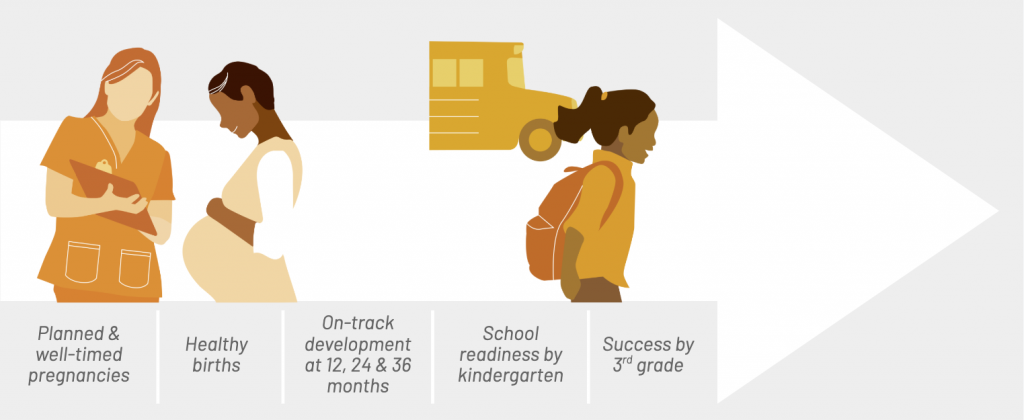Field Notes
How Do You Design for Population-Level Change? Field Notes from Guilford County, Part II
Across North Carolina’s Guilford County, leaders and community members are partnering to ensure that the county’s 37,000 0 to 5-year olds, and the 6,000 children born each year, are on a path to lifelong success when they begin Kindergarten.
Led by Ready for School, Ready for Life and The Duke Endowment, the Get Ready Guilford Initiative (GRGI) aims for population-level outcomes and reduced disparities for young children and their families.
To get there, GRGI is building a county-wide system of care. Root Cause is contributing by helping 13 early childhood programs strengthen their measurement capacity, improve program quality, connect their work, and tackle the big systemic issues affecting Guilford families.
We are striving to shape our work so it matters for Guilford’s children and their families. This is a play-by-play of how we are doing and what we are learning. We’re questioning everything. It’s complex. It might take a while. There’s local energy and commitment to tap into. This is what working toward community-level change looks like in real life.
This post is written by Anand Dholakia, a Principal at Root Cause and member of its Guilford County project team. Anand works with early childhood and county health programs on continuous quality improvement, facilitates a Community of Practice, and contributes to the project’s strategic direction.

Defining Success
When we first began our capacity-building and collective action role in Guilford County, NC, we realized the need to approach it differently if we were to live our mantra of making a real and meaningful difference via our work.
We began with the benefit of Get Ready Guilford’s (GRGI) leaders viewing success in terms of population-level improvement and reduced disparities in five outcome indicators along an early childhood pathway.
Of course, there are many interim and ancillary outcomes, and many that are required for lifelong success beyond third grade, but this would set a clear, initial target for the entire county to focus on.
I’d like to unpack this success definition one element at a time. First read the following:
Our goal is improvement in five outcome indicators along an early childhood pathway.
While we love numbers as much as the next consultant, we first acknowledged that our work is about what those numbers represent – the lives of children and their families. The point was not to to display charts with pastel hued, Mt. Everest-inclined bars in a PowerPoint slide, but rather to improve lives in a meaningful way that would then be reflected in improved data. Thus, we translated this first element of success into a simple goal to keep in mind: improve at least one child or parent’s life.
You may be thinking “nice going Root Cause, could you set the bar any lower?” However, we saw this as a crucial first level to establish considering how many tasks, meetings, reports, and even multi-million dollar initiatives we had experienced where it was not clear that anyone outside our circle would ever know the difference.
By first setting the bar to improve even one person’s life we are forced to look beyond process, output, or organizational results as success, such as showing increases in organizational capacity or cross-program collaboration (which we incidentally do track). It’s certainly not new for funders and intermediaries to hold nonprofit service providers accountable for producing life outcomes, but we often avoid holding ourselves to this same standard.
Defining Population Level
Next let’s go one step further:
Our goal is population-level improvement in five indicators along an early childhood pathway:
Adding the two words ‘population-level’ forces some more thinking. First, we thought “right, so… what does population-level actually mean…?” We took the perspective that GRGI aims to improve lives for children and families across the place that is Guilford County. The benefits would not accrue just to a select few, lucky families that were able to participate in a certain program or public resource. And we would see such benefits show up in county-level data, sometimes referred to as “moving the needle.”
Now, we do not yet have specified targets for those county-level indicators. Again, it’s not all about numbers – it’s about the people those numbers represent.
Yet, even without explicit % targets to hit, these two words set the bar way, way higher. With ‘population-level’ added, we are now forced to consider the broader context for our work, its role relative to others, how many people we need to affect, the broader conditions and systems that help or hinder success, the great variation in profile and needs across a ‘community,’ and many other factors.
Reducing Disparities
And now the last but most crucial element:
Our goal is population-level improvement and reduced disparities in five indicators along an early childhood pathway.
First, while the word ‘disparities’ is often associated with ‘racial disparities,’ we acknowledge that significant disparities exist based on race and class, citizenship status, gender, geography, and other factors. And these factors are highly correlated.
But whichever disparities we would aim to focus on, a ‘rising tide lifts all boats’ approach is no longer sufficient. Tackling disparities forces us to consider that not everyone has the privilege of owning a seaworthy boat, or access to a boat at all. Some live in areas where a rising tide may lead to flooding.
Tackling disparities forces us to consider what drives them in the first place, and doing that can quickly illuminate highly complex, entrenched, systemic issues. Making any noticeable dent in reducing disparities would need to include tackling these issues, in addition to targeting services and resources where they are needed.
This Is…Not Easy
Once we begin digging into the above definition of success, it can seem overwhelming. It is harder to capture the breadth and complexity of what drives what else. It can make our work appear inadequate. Not to mention make us wary of accountability to an ambitious goal that our work may later fail to achieve. And we definitely wouldn’t be able to neatly capture it in a PowerPoint bullet list.
Facing the sheer terror of the above challenges (imagine Godzilla thundering down a city street toward a social sector conference hotel, wearing a t-shirt with a busy theory of change diagram and all the screaming attendees running for cover – “Aagghh, my eyes! There’s too many boxes!” ; “I can’t see!” ; “Why couldn’t he just wear bullet points??!”), we have often found ourselves and our peers narrowing our success definitions and oversimplifying how we look at problems and solutions to suit our own needs. Now we ask ourselves, who do we serve with this approach? We may serve ourselves, colleagues, partners, and funders, but we don’t always do our communities any favors.
Will Root Cause’s own capacity building and network role achieve the above definition of success? Of course not… but we aim to maximize our contribution to it. Can GRGI as a whole and its partners achieve it? We sure hope so; that’s the plan.
Embracing the higher bar of success and all its inherent complexity, we began preparing ourselves for the work. Had this project started only a couple years earlier, we would have completed interviews, read documents, checked off that box, and then plunged into designing a capacity-building program and running an open process for programs to apply.
This time, we went deeper. We learned a lot that led us to go about our work quite differently, in ways that we could not have predicted. And we learned much that we didn’t know what to do with, leading to some uncomfortable insights and tricky questions without clear answers. Stay tuned for more updates from Guilford County.


